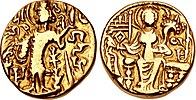
 A "Gadahara" coin (left) and its Gadahara monogram (right).
A "Gadahara" coin (left) and its Gadahara monogram (right).Obverse: Several names appears on the obverse, vertically
Right field: The name ![]()
![]()
![]()
![]() Ga-ḍa-ha-ra appears vertically in the right field as a monogram.
Ga-ḍa-ha-ra appears vertically in the right field as a monogram.
Middle field: This issue has the name Pi-ro-ysa (![]() Pi-ro-ysa), thought to be Peroz III Kushanshah, under the arm of the standing ruler.
Pi-ro-ysa), thought to be Peroz III Kushanshah, under the arm of the standing ruler.
Reverse: Goddess Ardoxsho seated. Minted circa 350-375 CE.
Gadahara (Brahmi: ![]()
![]()
![]()
![]() Ga-ḍa-ha-ra), sometimes Gadakhara (Brahmi:
Ga-ḍa-ha-ra), sometimes Gadakhara (Brahmi: ![]()
![]()
![]()
![]() Ga-ḍa-kha-ra), is a name appearing on numerous coins at the end of the Kushan Empire or the beginning of the rule of the Kidarite Huns in the area of Central and Western Punjab in India, in the period circa 350-375 CE.
Ga-ḍa-kha-ra), is a name appearing on numerous coins at the end of the Kushan Empire or the beginning of the rule of the Kidarite Huns in the area of Central and Western Punjab in India, in the period circa 350-375 CE.
The name ![]()
![]()
![]()
![]() Ga-ḍa-ha-ra appears vertically as a monogram in the right field of the coins. Then several name appear under the arm of the ruler, including Yasada, Piroz, Kirada and Samudragupta.
Ga-ḍa-ha-ra appears vertically as a monogram in the right field of the coins. Then several name appear under the arm of the ruler, including Yasada, Piroz, Kirada and Samudragupta.
It is not known with certainty whether Gadahara is actually the name of a ruler, or a clan, or a geographical region, although modern scholarship considers it is indeed the region of Gandhara.
The appearance of the names of foreign rulers such as the Kushano-Sassanian Piroz (![]() Pi-ro-ysa) or the Samudra, Some historians speculated it to Samudragupta (
Pi-ro-ysa) or the Samudra, Some historians speculated it to Samudragupta (![]()
![]()
![]() Samudra) may suggest some kind of suzerainty at a time when the remnants of Kushan power were torn between these two powers.
Samudra) may suggest some kind of suzerainty at a time when the remnants of Kushan power were torn between these two powers.
The Gadahara coins may be the last of the Kushan coins before the invasion of the Kidarites. But it is often thought that these coin actually were issued by the Kidarites themselves, who were invading the Kushan realm around that time, although they seem to come chronologically just before the issues of the famous Kidarite ruler Kidara.
Other coin issues of Gadahara
-
 Another "Gadahara" coin, with the name "Kirada" (
Another "Gadahara" coin, with the name "Kirada" (

 ) as a vertical monogram under the arm of the King.
) as a vertical monogram under the arm of the King.
-
 "Gadakhara" coin with the name of the Samudra (Ocean) (
"Gadakhara" coin with the name of the Samudra (Ocean) (

 Samudra) under the arm of the king. Circa 350-375 CE.
Samudra) under the arm of the king. Circa 350-375 CE.
References
- Tandon, Pankaj (2009). "The Western Kshatrapa Dāmazāda". The Numismatic Chronicle. 169: 177. JSTOR 42678610.
- ^ A Comprehensive History of India. Orient Longmans. 1957. p. 253.
- ^ Tandon, Pankaj (2009). "An Important New Copper Coin of Gadahara". Journal of the Oriental Numismatic Society (200): 19.
- Bhavan, Bharat Kala; Sharma, Savita (1999). Gold Coins of Imperial Kushāṇas and Their Successors in Bharat Kala Bhavan. Bharat Kala Bhavan, Banaras Hindu University. p. 18.
- ^ Dani, Ahmad Hasan; Litvinsky, B. A. (1996). History of Civilizations of Central Asia: The crossroads of civilizations, A.D. 250 to 750. UNESCO. pp. 165–166. ISBN 9789231032110.
- ^ Agrawal, Ashvini (1989). Rise and Fall of the Imperial Guptas. Motilal Banarsidass Publ. p. 128. ISBN 9788120805927.
- Cribb, Joe. "The Kidarites, the numismatic evidence.pdf". Coins, Art and Chronology II, Edited by M. Alram et Al.
- ^ "Gadahara. The last branch, in course of time, yielded to Samudragupta, as is borne out by certain coins of this branch having the name Samudra. There is a good deal of similarity between the coins of the Gadaharas and the Kidara Kushanas." in Bajpai, K. D. (2004). Indian Numismatic Studies. Abhinav Publications. p. 112. ISBN 9788170170358.